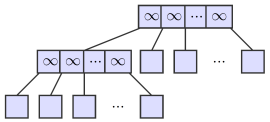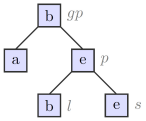Notes of Non-blocking k-ary Search Trees
About k-ary Search Trees
- No duplicate key
- Leaf-oriented k-ST
- Each leaf has zero children and at most k - 1 keys
- Each internal node has exactly k children and k − 1 keys (in increasing order)
Non-blocking k-ary Search Trees需要平衡,tree的深度和每个internal node进行search和update时的work总量。
大的k–>减少tree的depth,但是增加了每个internal node进行search和update时的work总量。
k = 4的时候,在高contention和低contention的情况下,性能都是最好的。 高contention时,较少的小k减少了update时影响到的key的数目,增加了并行度;低contention时,较少的depth加快了search,加快了update。
From BST to k-ary Search Trees
- Insert: the BST’s insertion -> sprouting insertion
- Delete: the BST’s deletion -> pruning deletion
- Coordination: extended from BST
Data Structure
Nodes
Each leaf has zero children and at most k − 1 keys (zero keys is permitted). Each internal node has exactly k children and k − 1 keys. Inside each node, keys are maintained in increasing order.
Dummy Nodes
Dummy nodes are used in BST to avoid special cases when there is no parent or grandparent to flag and mark. The following pruning deletion operation will meet similar problem. When perform pruning deletion, the leaf may won’t have a parent or grandparent. To avoid dealing with that, dummy nodes and empty leaves used again when initializing the tree.

- Dummy nodes: each have k − 1 keys valued $\infty$.
- Empty leaves: 2k - 1 empty keys in total.
Sequential Operations
Insertion
Search for the key first.
Sprouting Insertion
If the leaf is full, replaces the leaf by a newly created subtree.
The newly created subtree:
- The k - 1 greatest keys among the original k - 1 keys and the new key.
- The children are k (the original k - 1 keys and the new key) new nodes.
Simple Insertion
If the leaf is full, replaces the leaf by a newly leaf with k keys (the original k - 1 keys and the new key).
Deletion
First search for the key.
Pruning Deletion
If the leaf has one key and the parent of leaf has exactly two non-empty children, replace the parent with the sibling of leaf.
Simple Deletion
If the leaf has more than one key or the parent of leaf has more than two non-empty children, replace the leaf by a new leaf with key removed.
Coordination
Interleaved execution between concurrent updates in some particular order may cause problems (of cause).
The Coordination is similar to BST, but here the scheme is extended.
The following UpdateStep (ReplaceFlag, PruneFlag and Mark) objects is just like lock.
ReplaceFlag
For both types of insertion and simple deletion.
PruneFlag
For pruning deletion.
Mark
Before an internal node is to disappear from the tree, it must first be marked. Once a internal node is marked, its child pointer will never be changed.
Clean
Initial stat of the pending filed in internal node.
Help Mechanism
If an operation is unexpectedly delayed while holding access to a flagged or marked node, the progress cannot be guaranteed. So helping mechanism is necessary. The method taken here is similar to the one in BST.
But the helping should not be abused. To avoid many duplicate operation, the helping is used in limited cases.
On The Whole
Just for clear the thought.
The following picture isn’t presented in the paper. Because the idea in the paper is similar to BST. So it easy to imitate the original one in BST.

ReplaceFlag is used in simple insertion, sprouting insertion and simple deletion. So the original notations, ichild ..., dchild ..., etc won’t apply.
Differences between BST and k-ary Search Trees
Deletion
There two types of deletion in k-ary Search Trees. And a particular interleave of insertion and deletion would result in key lost.

Suppose there are some nodes in k-ary search tree (see above figure) and two threads concurrently perform update.
- Thread ti: insert d at b (the order doesn’t mater)
- Thread td: delete b
The following operation sequence is executed (direction of child isn’t mentioned, but it should be fairly easy to see),
- td:
PruneFlaggp - ti:
ReplaceFlagp from now on, the p won’t be marked by td until ti finished. - ti: Finish insertion and
Cleanp - td: Mark p
- td: Change the pointer in gp to s
Consequence: Insertion of key, d is lost. :(
The problem is that pruning deletion changes the child of gp to the child of p without knowing the modification in the another child of p.
Above problem won’t happen in BST’s deletion, since the new node (internal node or leaf) is always built from scratch.
So the pending of p must be read before PruneFlag set at gp and checked when performing mark cas. If any insertion occurred, the pending of p will be bound to changed and deletion will perform backtracking cas and restart.
BTY: In BST and k-ary search tree, the pending of p is already read by the end of search and the above prerequisites in implementation is already done. But it has special purpose and meaning here.
Some Doubts
CAS and CASet
In k-ary search trees, CASet (compare-and-set) is used to implement CAS.But the prerequisites is the algorithm doesn’t suffer from the ABA problem.
| |
The reason why these algorithms doesn’t suffer from ABA problem is quite clear for me. But what does the prerequisites (doesn’t suffer from the ABA) for?
References
- Non-blocking k-ary Search Trees, Trevor Brown, Joanna Helga
- Non-blocking Binary Search Trees, Faith Ellen, Panagiota Fatourou, Eric Ruppert, Franck van Breugel